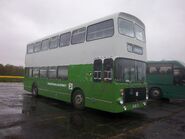The Volvo Ailsa B55 was a front-engined double-decker bus chassis built in Scotland by Ailsa, Volvo's British

1975 Volvo Ailsa B55
commercial vehicle agency. It was in production from 1973 to 1985, and was a relatively successful alternative to the ubiquitous rear-engined Bristol VR, Leyland Atlantean and Daimler/Leyland Fleetline of the period.
The vehicle first appeared at the 1973 Scottish Motor Show, and was well received.
Versions[]
The chassis was designed with a front mounted engine that still allowed a front entrance position suitable for one-person operation. In this sense there was a common goal with the earlier, unsuccessful, Guy Wulfrunian. The engine was the Volvo TD70, a compact turbocharged unit of 6.7-litres. The rest of the design was relatively simple, with beam axles and leaf springs. A Self-Changing Gears semi-automatic gearbox was used.
A prototype lowheight Ailsa, designated B55-20 (instead of the standard B55-10), was built for the Scottish Bus Group for operation in the Highlands with Highland Omnibuses. When SBG first looked at the prototype, they ran a mile, thus no more were built. Derby Borough Transport bought the bus in 1977. It remained a one-off and is now owned by WJC Coaches in Scotland.
In 1977 an improved MkII version appeared, with two transmission options offered - a Self-Changing Gears pneumocyclic unit and a Voith D851 with retarder. It was followed in 1980 by a MkIII version, for which the Ailsa name was dropped. This continued to use the Volvo TD70H turbocharged engine, and utilized a Volvo truck rear axle in place of the previous troublesome axle. Air suspension was also an available option.
In 1981, a 3-axle version of Ailsa B55 was developed to meet the demand of 3-axle buses in Hong Kong.
Operators[]
The Ailsa B55 type was particularly popular with the Scottish Bus Group, as well as Tayside Region and Strathclyde PTE. Significant orders also came from West Midlands PTE and South Yorkshire PTE and to a lesser degree Merseyside PTE. Ayrshire independent operator A1 Service, whose operating area included the Ailsa plant in Irvine, also purchased several of the vehicles new, increasing its fleet where it could through the purchase of used vehicles.
As part of its Alternative Vehicle Evaluation program, London Transport took delivery of three MkIII vehicles in 1984. The program was intended to evaluate alternative vehicle types for future fleet replacement in London, which at that time was purchasing Leyland Titans and MCW Metrobuses. The most interesting of the three vehicles was fleet number V3. This vehicle maintained the usual front entrance door, but had an additional exit behind the rear axle, and a second staircase adjacent. This had the advantage of improving passenger flow during loading and off-loading at peak times. But, the second staircase created a blind spot for the driver, and the vehicle was restricted to crew operation. The vehicle remained unique, although London Buses rebuilt the rear, removing the doors, but leaving the staircase in place. After a fatal crash on a stormy night in which V3 crashed into a Mini and turned over on its side, the bus was sold for scrap. V3 was rescued from a scrap dealer by Black Prince of Morley, and extensively rebuilt, still keeping both staircases. Upon closure of Black Prince, this vehicle was purchased by Roger Wright's London Bus Company Ltd. and can now be seen restored to London condition at rallies and running days across Southern England.
No further orders for new B55s were placed by London Transport, but numerous second-hand examples were purchased from South Yorkshire PTE and West Midlands PTE in the late 1980s.
A solitary Ailsa chassis was bodied as a single-deck bus by Marshall for Strathclyde PTE. Later, the same operator created a second single-decker, by converting an Alexander-bodied double-decker, the upper deck of which had been damaged.
A number of 2-axle Ailsa B55 were sold overseas. Indonesia received 320 buses between 1981 and 1985. China Motor Bus in Hong Kong received eight between 1975 and 1978 (six out of these eight buses were destroyed by fire). One B55 was exported to Singapore as a demonstrator for Singapore Bus Services.
A total of three 3-axle Ailsa B55s were built for export, two were sold to China Motor Bus as demonstrators, and the third was exported to Indonesia.
In all, just over one thousand B55s were built, 890 of them having bodywork by Scottish bodybuilder Alexander. Of the remainder, 64 Ailsas received unusual Vanhool McArdle bodies built in Dublin - 62 buses for the South Yorkshire PTE and 2 for A1 Service, Ayrshire. 4 of these buses survive in preservation, and can be seen on the website of the Sheffield based 388 Group.
The last significant number of Ailsas in service in the UK were operated by Cardiff Bus, who had 18 in regular service in 2007. They were withdrawn at the end of 2007 and replaced by new Scania double-deckers. However, ten Ailsas remain in service for school work, school contracts and rail replacement with Edwards Coaches of South Wales, with all being ex-Cardiff as of August 2010.
There are now around 30 Volvo Ailsas preserved worldwide, with most at home in Scotland.

